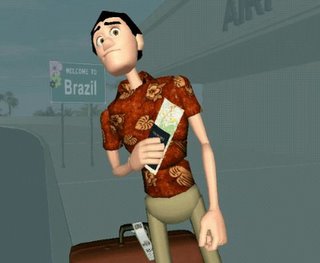
Gestures in animation can be so many things. I recently gave a talk on gestures for
Animation Mentor. The talk really helped me delve into what a gesture is and why people do them. Gestures can be signals that tell a person how you are feeling. Some are primary and others are secondary. A primary gesture might be the one on the photos I grabbed from various sources. The fist in the air says "I have won" or celebrates something. The meaning of your gestures really depend on the situation and the character. As seen in the photo of the golfer, his way of celebrating is much more low key, as it should be on the golf course.
A good example of a secondary gesture might be a person putting his hand up to his mouth to cover a cough. It's an almost involuntary thing and it also tells the person seeing this that he is sick.
In animation, we tend to think of gestures as something that accompany dialogue. Its very easy to make boring choices when you are animating. Myself included, sometimes I just don't think things through. You really do need to explore all the possibilities to make your scene fresh. Here are a few tips.
1) Avoid twinning
2) Try to stay away from over used gestures such as the W pose or the point.
3) Think about your character and what types of gestures they might use.
4) Try to come up with a gesture that is interesting
5) Don't gesture. If it doesn't need to be there, then don't use one
6) Do your homework... Research, Thumbnail, people watch.I have to say, I have been guilty of having a character gesture too much like myself (in the case of Monsters with Mike Wazowski). For that character, it worked, but I am always struggling to come up with interesting ideas and poses. Heck, actors can do it, why cant we?
I heard a great exercise that actors were doing in a class I was sitting in on. Go out and people watch for a few hours and take 3 gestures from different people and use them in a scene. It worked out great. One of the actors was stroking her hair, waving and putting her hand to her mouth. I thought it was a great way to study gestures.
Try it out and let me know how it works... If only I could get my students to do the assignment....
Some great reading for this type of thing is:
MANWATCHING: A FIELD-GUIDE TO HUMAN BEHAVIOUR. Desmond Morris
and GESTURES: THEIR ORIGINS AND DISTRIBUTION by Desmond Morris
http://www.desmond-morris.com/books.phpHappy Holidays,
Andrew



